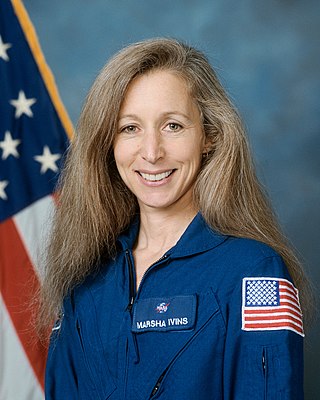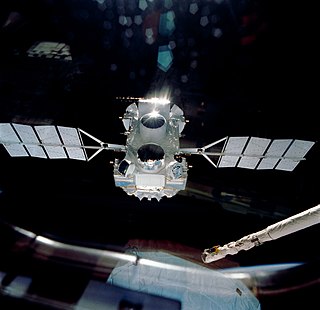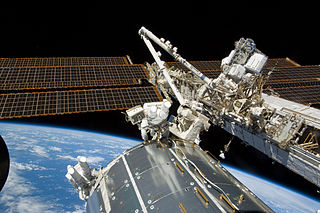
Space Shuttle Atlantis is a retired Space Shuttle orbiter vehicle which belongs to NASA, the spaceflight and space exploration agency of the United States. Atlantis was manufactured by the Rockwell International company in Southern California and was delivered to the Kennedy Space Center in Eastern Florida in April 1985. Atlantis is also the fourth operational and the second-to-last Space Shuttle built. Its maiden flight was STS-51-J made from October 3 to 7, 1985.

STS-6 was the sixth NASA Space Shuttle mission and the maiden flight of the Space ShuttleChallenger. Launched from Kennedy Space Center on April 4, 1983, the mission deployed the first Tracking and Data Relay Satellite, TDRS-1, into orbit, before landing at Edwards Air Force Base on April 9, 1983. STS-6 was the first Space Shuttle mission during which a Extravehicular activity was conducted, and hence was the first in which the Extravehicular Mobility Unit (EMU) was used.

STS-41-C was NASA's eleventh Space Shuttle mission, and the fifth mission of Space Shuttle Challenger. The launch, which took place on April 6, 1984, marked the first direct ascent trajectory for a Space Shuttle mission. During the mission, Challenger's crew captured and repaired the malfunctioning Solar Maximum Mission satellite, and deployed the Long Duration Exposure Facility (LDEF) experimental apparatus. STS-41-C was extended one day due to problems capturing the Solar Max satellite, and the landing on April 13, 1984, took place at Edwards Air Force Base, instead of at Kennedy Space Center as had been planned. The flight was originally numbered STS-13.

Jerry Lynn Ross is a retired United States Air Force officer, engineer, and a former NASA astronaut. Ross is a veteran of 7 Space Shuttle missions, making him the joint record holder for most spaceflights.

Marsha Sue Ivins is an American retired astronaut and a veteran of five Space Shuttle missions.

STS-51-D was the 16th flight of NASA's Space Shuttle program, and the fourth flight of Space Shuttle Discovery. The launch of STS-51-D from Kennedy Space Center (KSC), Florida, on April 12, 1985, was delayed by 55 minutes, after a boat strayed into the restricted Solid Rocket Booster (SRB) recovery zone. STS-51-D was the third shuttle mission to be extended.

STS-51-G was the 18th flight of NASA's Space Shuttle program, and the fifth flight of Space Shuttle Discovery. The seven-day mission launched from Kennedy Space Center, Florida, on June 17, 1985, and landed at Edwards Air Force Base, California, on June 24, 1985. Sultan bin Salman Al Saud from Saudi Arabia was on board as a payload specialist; Al Saud became the first Arab, the first Muslim, and the first member of a royal family to fly into space. It was also the first Space Shuttle mission which flew without at least one astronaut from the pre-Shuttle era among its crew.

STS-37, the thirty-ninth NASA Space Shuttle mission and the eighth flight of the Space Shuttle Atlantis, was a six-day mission with the primary objective of launching the Compton Gamma Ray Observatory (CGRO), the second of the Great Observatories program which included the visible-spectrum Hubble Space Telescope (HST), the Chandra X-ray Observatory (CXO) and the infrared Spitzer Space Telescope. The mission also featured two spacewalks, the first since 1985.

Shannon Matilda Wells Lucid is an American biochemist and retired NASA astronaut. She has flown in space five times, including a prolonged mission aboard the Russian space station Mir in 1996, and is the only American woman to have stayed on Mir. From 1996 to 2007, Lucid held the record for the longest duration spent in space by an American and by a woman. She was awarded the Congressional Space Medal of Honor in December 1996, making her the tenth person and the first woman to be accorded the honor.

Karol Joseph "Bo" Bobko was an American aerospace engineer, U.S. Air Force officer, test pilot, and a USAF and NASA astronaut. Bobko was the first graduate of the U.S. Air Force Academy to travel in space and the first person to fly on a space shuttle on three different missions: STS-6, STS-51-D, STS-51-J.

Richard Oswalt Covey is a retired United States Air Force officer, former NASA astronaut, and a member of the United States Astronaut Hall of Fame.

STS-112 was an 11-day Space Shuttle mission to the International Space Station (ISS) flown by Space ShuttleAtlantis. Space Shuttle Atlantis was launched on 7 October 2002 at 19:45 UTC from the Kennedy Space Center's launch pad 39B to deliver the 28,000 pound Starboard 1 (S1) truss segment to the Space Station. Ending a 4.5-million-mile journey, Atlantis landed at 15:44 UTC on 18 October 2002 on runway 33 at the Kennedy Space Center's Shuttle Landing Facility.

Brewster Hopkinson Shaw Jr. is a retired NASA astronaut, U.S. Air Force colonel, and former executive at Boeing. Shaw was inducted into the U.S. Astronaut Hall of Fame on May 6, 2006.

Mary Louise Cleave was an American engineer and NASA astronaut. She also served from 2005 to 2007 as NASA Associate Administrator for the Science Mission Directorate.

David Carl Hilmers is a former NASA astronaut who flew four Space Shuttle missions. He was born in Clinton, Iowa, but considers DeWitt, Iowa, to be his hometown. He has two grown sons. His recreational interests include playing the piano, gardening, electronics, spending time with his family, and all types of sports. His parents are deceased. With five academic degrees, he is the second most formally educated U.S. astronaut, behind Story Musgrave with six.

Steven Ray Nagel, , was an American astronaut, aeronautical and mechanical engineer, test pilot, and a United States Air Force pilot. In total, he logged 723 hours in space. After NASA, he worked at the University of Missouri College of Engineering as an instructor in its Mechanical and Aerospace Engineering Department.

Rodolfo Neri Vela is a Mexican scientist and astronaut who flew aboard a NASA Space Shuttle mission in the year 1985. He is the second Latin American to have traveled to space after Cuban cosmonaut Arnaldo Tamayo Méndez.

STS-129 was a NASA Space Shuttle mission to the International Space Station (ISS). Atlantis was launched on November 16, 2009, at 14:28 EST, and landed at 09:44 EST on November 27, 2009, on runway 33 at the Kennedy Space Center's Shuttle Landing Facility. It was also the last Shuttle mission of the 2000s.

STS-132 was a NASA Space Shuttle mission, during which Space Shuttle Atlantis docked with the International Space Station on May 16, 2010. STS-132 was launched from the Kennedy Space Center on May 14, 2010. The primary payload was the Russian Rassvet Mini-Research Module, along with an Integrated Cargo Carrier-Vertical Light Deployable (ICC-VLD). Atlantis landed at the Kennedy Space Center on May 26, 2010.

STS-135 was the 135th and final mission of the American Space Shuttle program. It used the orbiter Atlantis and hardware originally processed for the STS-335 contingency mission, which was not flown. STS-135 launched on July 8, 2011, and landed on July 21, 2011, following a one-day mission extension. The four-person crew was the smallest of any shuttle mission since STS-6 in April 1983. The mission's primary cargo was the Multi-Purpose Logistics Module (MPLM) Raffaello and a Lightweight Multi-Purpose Carrier (LMC), which were delivered to the International Space Station (ISS). The flight of Raffaello marked the only time that Atlantis carried an MPLM.






























